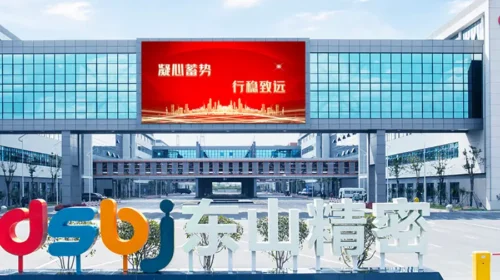GDS bets on new AI cycle while balancing expansion, deleveraging

The data center operator has begun listing its real estate assets to pay down debt as it races to capitalize on growing demand for AI computing
Key Takeaways:
- Data center operator GDS reported its third-quarter revenue rose 10.2% to 2.89 billion yuan
- The company generated 1.37 billion yuan from transferring some of its assets into a REIT, contributing to its net profit of 729 million yuan for the quarter
By Lee Shih Ta
For China’s data center industry, 2025 may go down as a watershed year. On one front, demand for AI training and inference has ignited a new infrastructure building cycle, creating new demand for high performance computing often housed in professionally operated data centers. Simultaneously, the listing of China’s first batch of infrastructure-oriented real estate investment trusts (REITs) for data centers is introducing a new fundraising instrument for this traditionally capital-intensive, highly leveraged sector.
That dynamic is embodied in GDS Holdings Ltd. (GDS.US; 9698.HK), which is investing heavily in infrastructure on expectation of growing AI demand from major tech firms, even as it grapples with the financial strain of building and operating billions of dollars worth of data centers.
GDS’ latest earnings report, released last week, shows the company’s third-quarter revenue rose 10.2% year-on-year to 2.89 billion yuan ($406 million), marking a second consecutive quarter of double-digit growth. The company secured new commitments for 75,000 square meters of capacity in the first nine months of this year, equivalent to roughly 240 MW. Full-year commitments are projected to approach 300 MW, with approximately 65% tied to demand for customers running AI-powered applications.
New order momentum slows
While AI demand is clearly fueling fresh demand for high-powered, offsite computing, the pace isn’t exactly happening at lighting speed. Management acknowledged on GDS’ earnings call that new order intake slowed after the second quarter, suggesting that revenue growth next year may not match this year’s pace. Furthermore, contract renewals continue to show some weakness, reducing monthly revenue per unit by 3% to 4%. This indicates that despite strong demand from AI clients, pricing pressure continues from more traditional internet clients.
Despite enjoying an important new source of demand from AI customers, GDS also still faces diminishing pricing power after a buildup of AI-ready capacity over the last few years, resulting in more than ample supply.
A more significant move for GDS came in the third quarter when it injected some of its data center assets, worth approximately 2.4 billion yuan, into China’s inaugural data center infrastructure REIT. The transaction generated a gain of roughly 1.37 billion yuan for the company, propelling it to a net profit of 729 million yuan for the quarter, moving it into the black.
Business model shift
The REIT strategy’s importance lies less in the one-time profit it brought for GDS, and more in the way it could fundamentally reshape the company’s operational model. For a decade, the company fueled its rapid expansion through heavy borrowing to acquire land and build facilities – a model used by many of its peers that works well during loose credit conditions. However, as China’s credit environment tightens, such a capital-intensive approach has become less attractive, leading to growing leverage that is increasingly constraining the company. But now, the use of REITs is providing a crucial alternative by allowing companies to offload their completed projects to investors, freeing up capital for new ones without relying so heavily on debt.
This shift has notably improved GDS’ financial structure, dropping its net debt-to-annualized-adjusted-EBITDA ratio to 6 times by the end of the third quarter from 6.8 times at the end of last year. Its average borrowing cost also declined to 3.3%. Such improvement shows the importance of REITs to the company’s strategy for reducing its debt, and thus reducing its interest expenses in China’s tightening credit environment.
GDS’ business model remains heavily reliant on the availability of power, a key operating factor for data center operators that is becoming even more important with the rise of power-hungry AI applications. The company’s current land bank comes with approximately 900 MW in supporting power quotas, enabling its rapid deployment of new projects, even with heavy requirements from AI customers. “Land with secured power quotas is becoming extremely scarce,” management highlighted during the earnings call.
While AI is generating substantial incremental demand for the company, it noted that supply side factors, including land, power, regulatory approvals, and pace of construction, are growing more competitive and policy sensitive.
The company’s 35.6% stake in overseas data center operator DayOne represents another strategic element for GDS. While possessing potential for business in Asia-Pacific and Europe, DayOne recorded a loss of 461 million yuan in the third quarter and will likely continue losing money over the near term. Still, GDS’ participation demonstrates its ability to develop, operate and keep monetizing new assets, rather than simply resting on its laurels.
GDS currently trades at a price-to-sales (P/S) ratio of approximately 4.15 times. That represents a significant discount to Equinix (EQIX.US) at 8.42 times and Digital Realty (DLR.US) at 9.31, but is higher than restructuring Chinese rival VNET Group (VNET.US) at just 1.99. Such a valuation suggests investors are relatively confident in GDS for its scale, client quality, and capital-recycling capabilities, despite risks inherent to the policy-driven and highly regulated Chinese market.
GDS’ Hong Kong-listed shares have gained about 30% this year, roughly in line with the broader market. But they’ve pulled back about 7% over the past month as excitement about their AI potential subsides. At its latest level of about HK$33, the stock trades roughly 33% below its 52-week high of HK$48.90. Given its persistent valuation discount and the likelihood for strong growth from new AI-driven demand, investors may want to give the stock a serious look. As a prominent AI infrastructure play, a stronger multiple could be plausible if AI demand holds firm and the company’s REIT asset injections proceed smoothly.
Nevertheless, shifting policies in China’s ever-changing regulatory environment warrant close monitoring as well, especially as the country crafts its new Five Year Plan that will dictate its priorities between 2026 and 2030. In sum, GDS is finding its way through a fundamentally new computing cycle, which has brought elevated market expectations but also leaves little room for missteps.
To subscribe to Bamboo Works weekly free newsletter, click here






